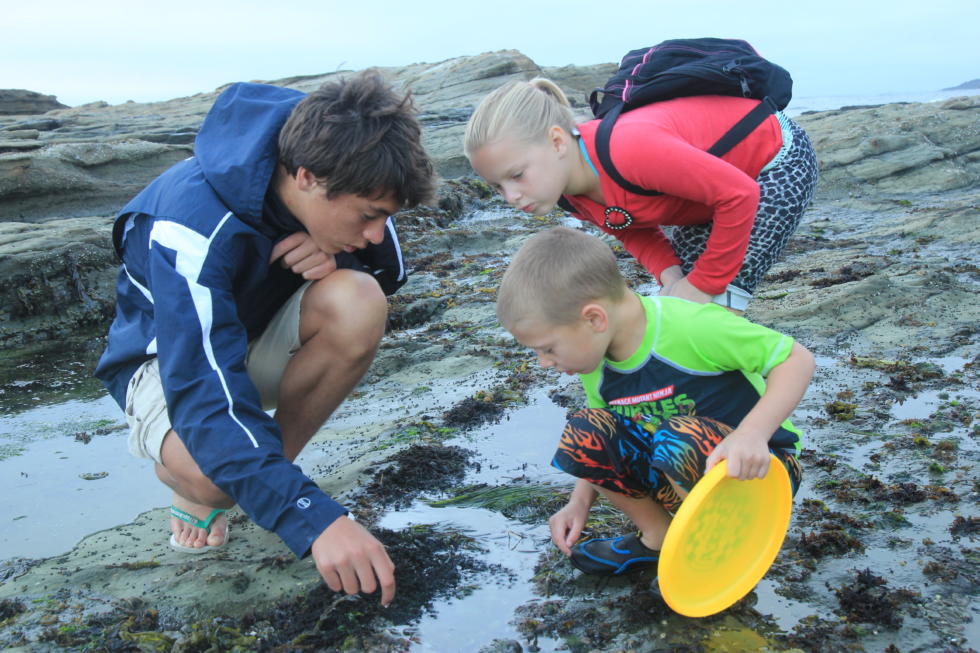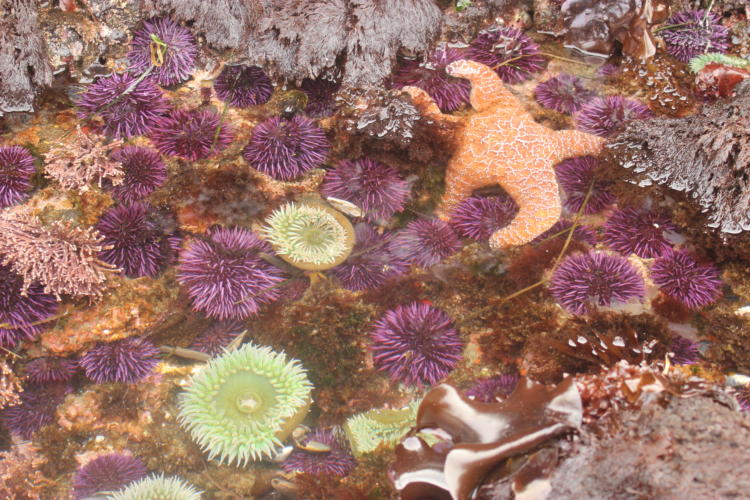Oregon’s rocky shores, often referred to as rocky intertidal or tidepool areas, form parts of the shoreward boundary of the nearshore planning area and can extend from the extreme low tide to the extreme high tide. They are characterized by CMECS as marine nearshore areas in the Intertidal and Supratidal zones, which include all hard substrate areas along the shoreline that are alternately exposed and covered by tides or are affected by wave splash and overwash, but not areas affected only by wind-driven spray. Everything beyond the reach of ocean waves is considered terrestrial habitat. The substrates making up Oregon’s rocky shores include both volcanic and sedimentary bedrock as well as megaclasts, boulder, cobble and human-made (anthropogenic) structures. Some rocky shore areas are extensions of other shoreline rocky features such as headlands or cliffs, others exist as isolated regions of rock surrounded by sandy beach habitat, and some are anthropogenic in origin, having been deposited intentionally or unintentionally by humans. Oregon’s coastline has approximately 152 linear miles of rocky shore habitat, and some 20 miles of jetties.
An example of a naturally-occurring geoform component found in Oregon’s rocky shores would be a tidepool. Some of the anthropogenic geoforms found in Oregon’s rocky shores include breakwaters, jetties, and rip rap deposits. All rocky shore habitats in Oregon are contained entirely within the Strategy’s planning area.
Physical Environment
The physical characteristics of rocky shores reflect local shoreline geology, exposure to ocean waves and currents, and biological influences. The Pacific Ocean exerts tremendous energy on Oregon’s rocky shoreline, eroding coves, widening crevices, and reducing bedrock to rubble. On the north and central coast volcanic basalt dominates the hard shoreline, but sedimentary sandstone and mudstone rock can found at several locations. Between Coos Bay and the Coquille River the geology is characterized by sedimentary rock. South of the Coquille River, headlands and rocks are primarily remnants of ancient metamorphic rocks over 200 million years old. Because of the variety of geologic origins and processes, Oregon’s rocky shores consist of an assortment of cliff faces, wave-cut platforms, boulder fields, outcrops, and rubble. Each geoform presents a unique mixture of habitats that provide shelter and substrate to support a wide variety of life.
Ocean forces and weather strongly influence rocky intertidal environments. Tides are the primary influence on organisms and communities. The physical environment of intertidal areas changes dramatically as the tide rises and falls, alternately covering everything with salt water or exposing it to air, fresh water from rain and runoff, and the sun. Wave exposure also has a primary influence on this environment. Intertidal areas protected from waves due to shoreline orientation or geology provide dramatically different habitat than areas directly exposed to wave action. Local alongshore currents and ocean circulation processes introduce additional variables in the habitat, including sand scour of rocks, seasonal sand burial of rocky areas, and transport of nutrients, larvae, and adult organisms to and from intertidal sites.
Biological Characteristics
Rocky shore habitats are known for and crucial to their abundant and diverse biological communities. The variety in tidal elevations, wave exposure, and geologic structure within and among intertidal habitats produces a variety of microhabitats, often within relatively small geographic areas. This, in turn, provides for a diversity of species adapted to life in these different microhabitats. Organisms contribute to the variety of habitats as well. For instance, mussels and algae attach themselves to the rocks, sometimes in huge numbers, providing additional structure and biogenic habitat used by intertidal species. Anthropogenic geoforms often take on similar biological characteristics of natural rocky shore geoforms, with similar biological communities using them.
Biological communities associated with rocky intertidal habitat include algae, marine plants, attached and mobile invertebrates, fish, marine mammals and birds. Strategy, Watch List, and other commonly associated species that utilize rocky shore habitat can be found in Table 6.3, Appendix E and F. Algae cover many intertidal areas with dense growth, often layered with several different species. Surfgrass, a marine vascular plant, often forms thick beds in lower intertidal areas, providing additional habitat structure for invertebrates and fish. Most rocky shore areas are extensively covered with attached invertebrates. Common types of attached organisms include sponges, anemones, barnacles, bryozoans, tunicates, and mussels. The rocks, algae, and attached invertebrates provide homes for a variety of mobile invertebrates such as crabs, snails, limpets, sea stars, urchins, brittle stars, nudibranchs, chitons, and worms. Free-swimming invertebrates, such as shrimps and drifting (planktonic) invertebrates also occur in tidepools or drift in with the tides. The algal and invertebrate communities in rocky intertidal areas often form distinct horizontal bands or zones of life according to the amount of time exposed to the air or covered by the tides.
The upper reaches of the supratidal and intertidal zones experience the greatest variation in moisture, exposure, and salinity, and are often highly dependent on strong wave action to bring in nutrients and life. Compared to other rocky shore areas, fewer species are found in the high intertidal and supratidal. These zones are typically characterized by vegetated rocks and boulders, along with isolated crevices and tidepools that hold water even during low tides. Greater abundance and diversity of life is associated with the lower intertidal areas. The distribution of organisms living in the mid-intertidal is generally limited at upper elevations by environmental stressors (such as high temperatures and desiccation) and at lower elevations by biological interactions (such as predation and competition). Organisms in the lowest parts of the rocky shore area experience almost continual tidal inundation, and must be able to withstand the mechanical and biological stresses associated with this high-energy environment.
The low intertidal serves as an important connection in the marine food web. Wave activity helps convert kelp and other organic debris into small fragments that are consumed by grazers and filter feeders and provide some nutrients to algal communities. Invertebrates and small fish provide a source of food for numerous bird species that forage along rocky shores.
Fishes using the rocky shore include species adapted to live in tidepools and subtidal species that move in and out of the intertidal area with the tides. Tidepool fishes include a variety of sculpins, gunnels, and pricklebacks, among others. Rockfish species, greenlings, and surfperch often move into the intertidal area during high tide to feed and take refuge from subtidal predators. The rocky shore area is especially important to juvenile life stages of these fishes. The rocks and islands associated with Oregon’s rocky shores and the subtidal rocky reefs provide important seal and sea lion haulout and pupping areas, and support some of the largest seabird nesting colonies on the contiguous U.S. West Coast. Islands are another example of geoforms in the CMECS framework. Several seabird species that do not nest in colonies in Oregon do feed and take refuge here, including black oystercatchers, black turnstones, and surfbirds.
Rocky shores are linked to surrounding habitats by ocean currents and organism movements. Currents bring in planktonic organisms that help feed intertidal animals, and transport drifting larvae to and from intertidal environments. Currents also bring nutrients that feed the lush algal growth. Many organisms move in and out of intertidal habitats to feed or take refuge. Fish move in during high tides and terrestrial animals move in during low tides. Rocky intertidal areas are also linked to each other, primarily through transport of larvae by ocean currents. The proximity of intertidal habitat to other “upstream” or “downstream” habitats has dramatic effects on the types, abundance, and recruitment rates of communities and organisms.
Ecological linkages within and between rocky shore areas help to shape biological communities and contribute toward the biological abundance of this habitat type. The diversity of producers and consumers in the intertidal create complex food webs and interdependencies among organisms. This complexity of organism interrelationships makes the outcome of natural or human disturbance to rocky shore habitats difficult to predict or measure. For instance, while human foot traffic can result in inadvertent trampling of organisms, anthropogenic structures such as jetties provide a unique and valuable rocky shore habitat at the transition between estuaries and the marine environment.
Human Use

Human uses of rocky intertidal areas include fishing, invertebrate and algae harvest and collection, education, scientific research, sightseeing, and other recreational, economic, and social pursuits. Due to their accessibility and the fascinating array of marine life, rocky intertidal areas receive more public use than many other marine habitats. Visitation by school groups and others curious about marine life comprises the majority of public use. For many visitors, their first and sometimes only interaction with the wonders of marine life comes from tidepool visits. Visitation of rocky shore areas has generally been increasing over the past five decades.
Rocky shores are used extensively by researchers as a natural laboratory to increase understanding about general marine ecological principles. Currently, there are fifteen intertidal and subtidal sites along the Oregon coast that have special regulations limiting harvest or collection of organisms in order to enhance scientific research, as well as education and enjoyment benefits.
Detailed descriptions of types and amount of human use at individual rocky shore sites along Oregon’s coast can be found in the Oregon Rocky Shores Natural Resources Inventory (ODFW 1994).
